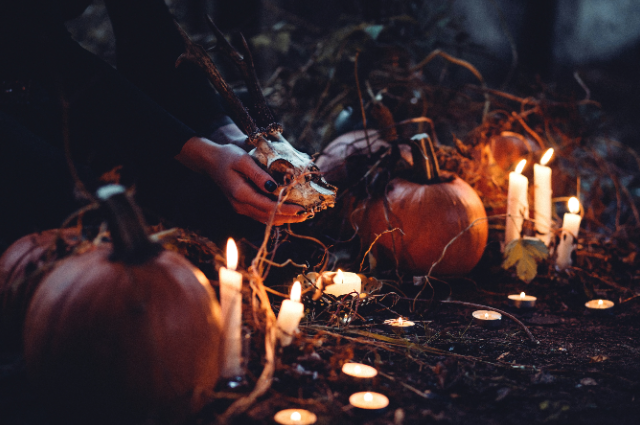
Photo by freestocks on Unsplash
It's likely that magic has been used since the dawn of time. It developed as a result of the necessity to govern and explain a frequently dangerous and hostile environment. Among the numerous things that baffled early humans were the earth, the sky, the stars and planets, birth, illness, and death. These must have appeared enigmatic and under the sway of unidentified, potent forces.
Numerous magical practices and rituals to influence the weather, animal behaviour, fertility, disease, death, and other seemingly uncontrollable elements sprang from attempts to understand the mysteries of the world and find means to manage at least some of them. People developed a primitive science as a result of their exploration and explanation of their surroundings, and this science eventually contributed to our understanding of chemistry, astronomy, medicine, and other natural sciences.
There are numerous and diverse connections and interactions between black magic and religion. Beyond the historical persecution of black magic by Christianity and its inquisitions, rituals related to religion and black magic share similarities.
Other traditions, like as Satanism, have been grouped together under the general heading of "black magic," thanks to the influence of popular culture. Although calling on demons or spirits is a recognised aspect of black magic, this is not the same as worshipping or divining such spiritual entities. The majority of mediaeval witchcraft beliefs mix the two.
According to Robert M. Place's 2009 book Magic and Alchemy, the roots of black magic can be traced back to the ritualistic, prehistoric worship of spirits, just like those of white magic. In contrast to white magic, which Place compares to early shamanic attempts to get intimately connected with spirits, the ceremonies that gave rise to contemporary black magic were intended to call upon the same spirits in order to provide advantageous results for the practitioner.
Place also offers a comprehensive contemporary explanation of black and white magic, choosing instead to designate them as "low magic" (black) and "high magic" (white) depending mostly on the practitioner's goals. However, he admits that this more inclusive definition (of "high" and "low") is biassed since, regardless of intention, ceremonial magic using pricey or exclusive components may be regarded as "high magic," while well-meaning folk magic may be regarded as "low." One kind of magic that is frequently used to hurt someone else is called black magic. It has a strong connection to the devil and was believed to be used by witches who had sworn allegiance to him during the 1692 Salem witch trials. With the use of spells, incantations, and other techniques, it is utilised to summon the forces of evil and darkness in an effort to manipulate natural forces. In contrast to black magic, white magic is seen as non-harmful to others.
Though both are believed to have the capacity to cause harm, even when unintentional (e.g., using a love charm to manipulate another person's emotions), it can be difficult to distinguish between the two. There are plenty of people that believe in black magic, despite the fact that most do not. For believers, the possibility of engaging in magick or falling victim to a hex, spell, or other damage is extremely real.
Many magical rites and acts were viewed as evil or irreligious during the Renaissance, and hence, black magic in its broadest sense. The Inquisition outlawed witchcraft and targeted esoteric studies that deviated from the mainstream. Thus, natural magic emerged as a means of advancing esoteric and ceremonial research (though still frequently in secret) without facing severe punishment for thinkers and intellectuals such as Marsilio Ficino, abbot Johannes Trithemius, and Heinrich Cornelius Agrippa.
However, the term was most frequently applied to people who were accused of calling upon demons and other evil spirits, hexes or cursing their neighbours, using magic to ruin crops, and having the ability to leave their physical bodies and travel great distances in spirit (a topic to which the Malleus Maleficarum "devotes one long and important chapter"), usually in order to worship the devil. Summers also elucidates the etymological evolution of the term "nigromancer," which was in widespread usage from around 1200 to 1500 (Greek: μαvτεία, divination; Latin: niger, black), which generally means "one skilled in the black arts".
The distinction between white magic and black magic is slightly more obvious in modern times, and most definitions place more emphasis on intention than on actual practice. In addition, a lot of contemporary witches and Wiccas have made an effort to keep their distance from people who only want to use black magic. In an era where friendly magic is increasingly associated with new-age practices and ideas, as well as self-help spiritualism, those who aim to do harm or evil are unlikely to find acceptance among mainstream Wiccan circles or covens.
In the thousands of years that magic has been evolving, it has taken on many different forms: voodoo, a synthesis of West African religions, Christianity, and local beliefs that were present in the West Indies during the slave trade; witchcraft, which began as a synthesis of various folk religious practices and mythologies from the Middle Ages; and Satanism, the worship of the devil. Shamanistic magic, on the other hand, involves leaving the body and communing with otherworldly spirits and teachers. Tribal magic is used by more primitive cultures to influence spirits associated with the tribe group and to counter evil sorcery directed at them.
In conclusion, opinions on the existence of black magic will probably continue to differ for some time to come. Some people could write it off as superstition, while others will keep looking for the secrets and hidden abilities that exist beyond the surface of reality. Whether examined from a social, psychological, or spiritual standpoint, the study of black magic provides an enlightening look into the human brain and its never-ending search for meaning and purpose.
